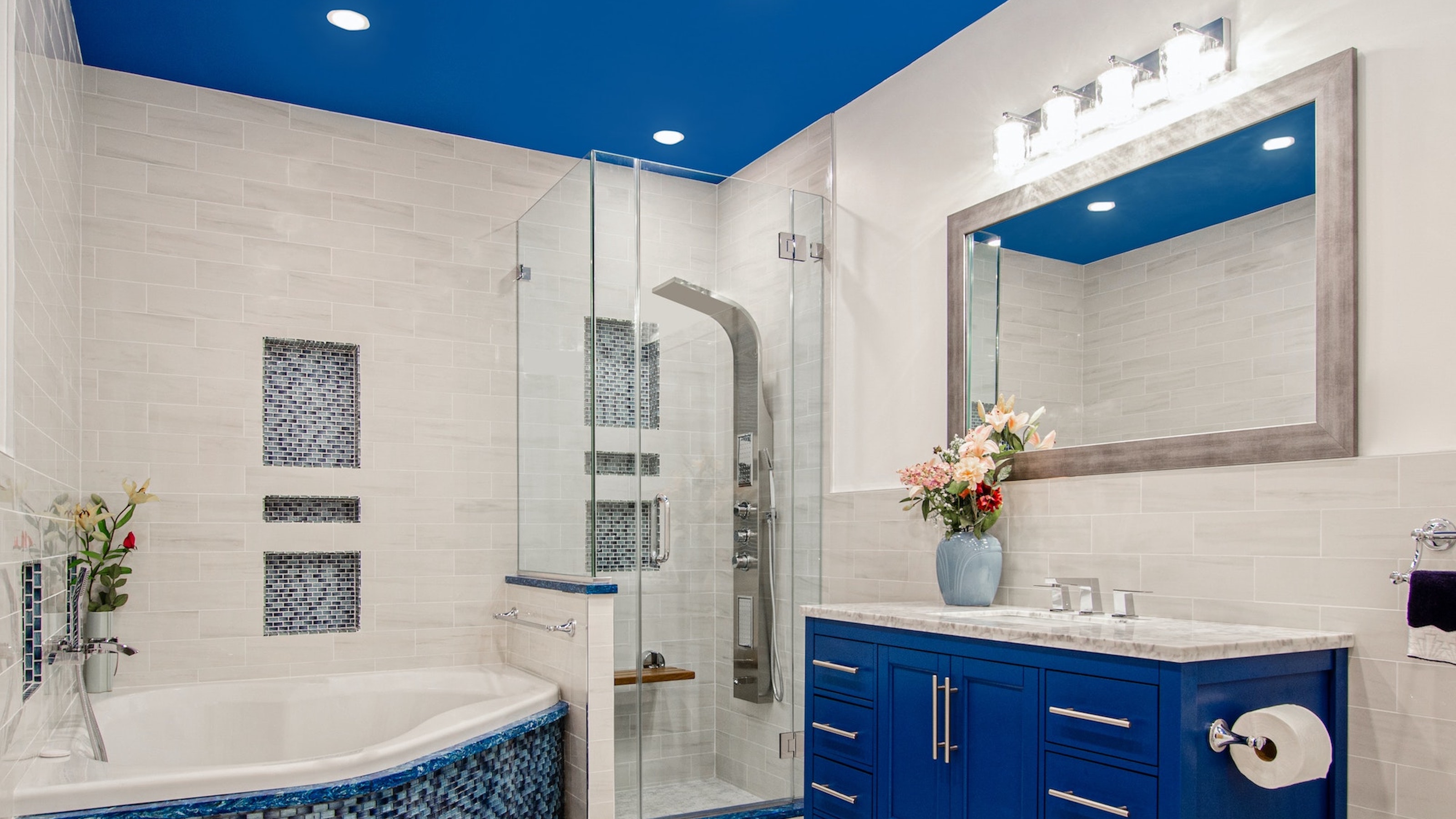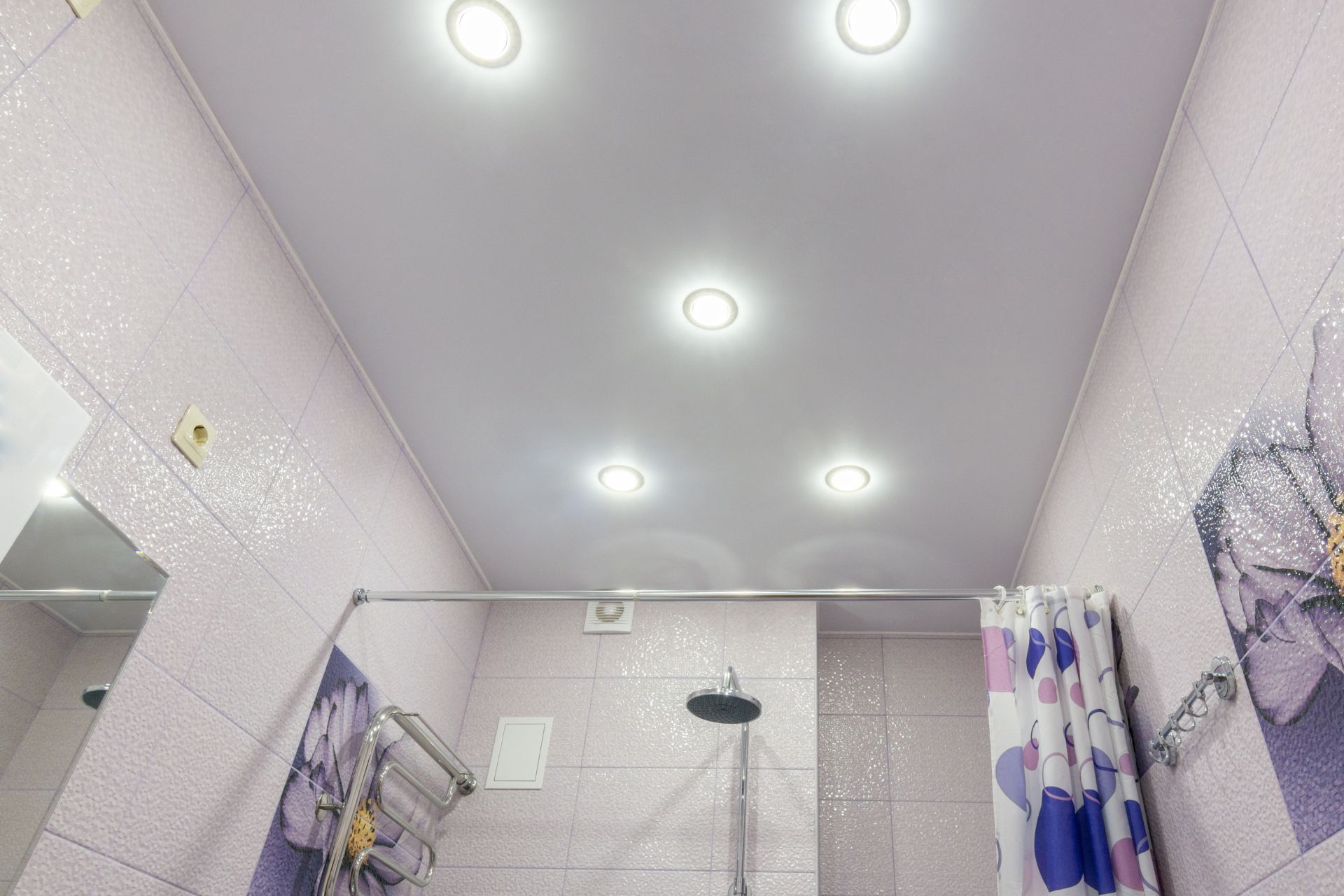Visualizing the Space: Ceiling Design For Small Bathroom
In a small bathroom, the ceiling plays a crucial role in shaping the overall perception of space. The height of the ceiling, as well as the choice of finishes, can significantly impact the feeling of spaciousness and light.
Impact of Ceiling Height
The height of the ceiling in a small bathroom directly influences the sense of space. A low ceiling can make the bathroom feel cramped and claustrophobic, while a higher ceiling can create an illusion of greater volume and openness. In a small bathroom, a higher ceiling, even if it’s just a few inches, can make the room feel significantly more spacious. This is because the eye is drawn upwards, creating a sense of verticality that can counteract the feeling of limited floor space.
Influence of Ceiling Finishes
The choice of ceiling finishes can also significantly influence the feeling of space and light in a small bathroom. Light-colored finishes, such as white or pale pastels, can reflect light, making the bathroom feel brighter and more spacious. Conversely, dark-colored finishes can absorb light, making the room feel smaller and more intimate.
- Glossy finishes reflect light more effectively than matte finishes, creating a sense of brightness and spaciousness.
- Textured finishes can add visual interest to the ceiling, but they can also make the room feel smaller if they are too busy or intricate.
- Wood-paneled ceilings can create a warm and inviting atmosphere, but they can also make the room feel more enclosed.
Ceiling Designs for Illusion of Larger Space
There are several ceiling designs that can create the illusion of a larger bathroom.
- Vaulted ceilings create a sense of height and openness, making the bathroom feel larger than it actually is. A vaulted ceiling can be particularly effective in a small bathroom with a low ceiling, as it draws the eye upwards and creates a sense of verticality.
- Tray ceilings are another effective way to create the illusion of height. A tray ceiling is a recessed area in the ceiling that is often framed with molding. This creates a sense of depth and dimension, making the bathroom feel larger.
- Coffered ceilings are a more elaborate type of tray ceiling, with multiple recessed panels. Coffered ceilings can add a touch of elegance to a small bathroom, and they can also help to create a sense of spaciousness.
Contrasting Colors to Highlight Features
Contrasting colors can be used to highlight specific features in a small bathroom. For example, a dark-colored ceiling can be used to create a sense of intimacy in a small bathroom, while a light-colored ceiling can be used to highlight a particular feature, such as a decorative chandelier or a skylight.
A good example of this would be a small bathroom with a white tiled floor and walls. A dark gray ceiling would create a sense of intimacy and focus attention on the light-colored tiles.
Maximizing Natural Light

A small bathroom can feel cramped and gloomy, but by strategically incorporating natural light, you can create a sense of spaciousness and tranquility. Maximizing natural light in a small bathroom can be achieved through a variety of design techniques, transforming the space into a bright and airy oasis.
Skylights: Illuminating Small Bathrooms, Ceiling design for small bathroom
Skylights are a fantastic way to flood a small bathroom with natural light. They can be particularly effective in bathrooms with limited window space, as they allow direct sunlight to penetrate the room from above. Skylights can be installed in various sizes and styles, with options for fixed, retractable, or even solar-powered models.
A well-placed skylight can make a small bathroom feel significantly larger and more inviting, while also reducing the need for artificial lighting during the day.
Light-Colored Paint and Finishes
Using light-colored paint or finishes on the ceiling can significantly enhance the perception of space and brightness. Light colours reflect more light, making the room appear larger and brighter.
White or off-white ceilings are popular choices, as they create a clean and airy feel. However, other light colours, such as soft blues, greens, or yellows, can also be effective.
Strategic Mirror Placement
Mirrors are a valuable tool for maximizing natural light in a small bathroom. Placing a mirror opposite a window allows natural light to bounce back into the room, effectively doubling the amount of light.
Consider using a large mirror on the wall opposite the window, or a smaller mirror strategically placed above the sink to reflect light onto the vanity area.
Light Well Design
A light well is a vertical shaft that allows natural light to penetrate deeper into a building. In a small bathroom, a light well can be incorporated into the design to maximise natural light.
A light well can be created by removing a portion of the ceiling and replacing it with a glass panel. This allows sunlight to enter the bathroom from above, creating a bright and airy space.
Functional Design Considerations

Ceiling design for small bathroom – A well-designed bathroom ceiling not only enhances aesthetics but also plays a crucial role in functionality. It’s important to consider the practical aspects of the space to create a comfortable and efficient bathroom experience.
Common Bathroom Ceiling Fixtures and Ideal Placement
Choosing the right fixtures and strategically placing them is vital in a small bathroom. Here’s a breakdown of typical fixtures and their optimal positioning:
- Light Fixtures: Recessed lighting is often preferred for small bathrooms as it provides even illumination without taking up valuable space. However, consider installing a central light fixture for general illumination and supplementing with task lighting, such as vanity lights, for specific areas.
- Exhaust Fan: A powerful exhaust fan is essential for removing moisture and odors. It should be located directly above the shower or bathtub to effectively draw out steam and prevent mold growth.
- Smoke Detector: A smoke detector is a safety requirement in most areas and should be installed on the ceiling, ideally in the center of the room for optimal coverage.
Recessed Lighting in Small Bathrooms: Benefits and Drawbacks
Recessed lighting is a popular choice for small bathrooms, offering several advantages. However, it’s important to weigh the pros and cons before making a decision.
- Benefits:
- Space-Saving: Recessed lights are mounted flush with the ceiling, minimizing the visual impact and maximizing headroom in a small bathroom.
- Even Illumination: They provide a consistent and diffused light, reducing harsh shadows and creating a more welcoming ambiance.
- Energy Efficiency: Recessed lights can be equipped with energy-saving LED bulbs, reducing electricity consumption and saving on utility bills.
- Drawbacks:
- Installation Complexity: Installing recessed lighting can be a more complex process than simply mounting surface-mounted fixtures, requiring cutting into the ceiling and potentially involving electrical work.
- Cost: Recessed lights tend to be more expensive than standard surface-mounted fixtures, especially if you opt for high-quality LED bulbs.
- Limited Lighting Options: The selection of recessed light fixtures may be more limited compared to the wide variety of surface-mounted options.
Using Waterproof Materials for Small Bathroom Ceilings
Moisture is a constant concern in bathrooms, making waterproof materials essential for the ceiling. Using waterproof materials helps prevent damage, mold growth, and potential health issues.
- Benefits:
- Moisture Resistance: Waterproof materials effectively resist moisture penetration, preventing water damage and mold growth, which are common problems in humid environments.
- Durability: Waterproof materials are typically more durable than traditional materials, able to withstand the constant exposure to moisture and steam without warping or deteriorating.
- Longevity: Using waterproof materials helps extend the lifespan of the bathroom ceiling, reducing the need for costly repairs or replacements in the future.
Installing a Ceiling Fan in a Small Bathroom: Process and Ventilation Impact
Installing a ceiling fan in a small bathroom can significantly improve ventilation and create a more comfortable environment.
- Installation Process:
- Choose a Fan: Select a bathroom-rated ceiling fan specifically designed for humid environments. Look for features like a moisture-resistant motor and a waterproof finish.
- Electrical Wiring: Ensure that the electrical wiring in your bathroom is adequate for the ceiling fan. If necessary, consult a qualified electrician for assistance.
- Mount the Fan: Install the fan according to the manufacturer’s instructions, making sure it’s securely mounted to the ceiling joists.
- Connect Wiring: Connect the fan’s electrical wiring to the existing bathroom wiring, ensuring all connections are secure and properly insulated.
- Test the Fan: Turn on the fan to test its operation and ensure all components are working correctly.
- Ventilation Impact:
- Moisture Control: A ceiling fan helps circulate air and remove moisture from the bathroom, reducing humidity and preventing mold growth.
- Improved Air Quality: By circulating air, the fan helps distribute fresh air and remove stale air, improving the overall air quality in the bathroom.
- Temperature Regulation: A ceiling fan can help cool the bathroom during warmer months, creating a more comfortable environment.
